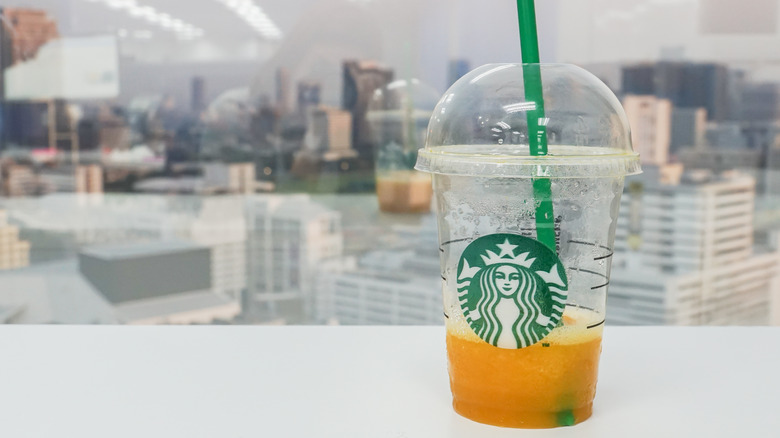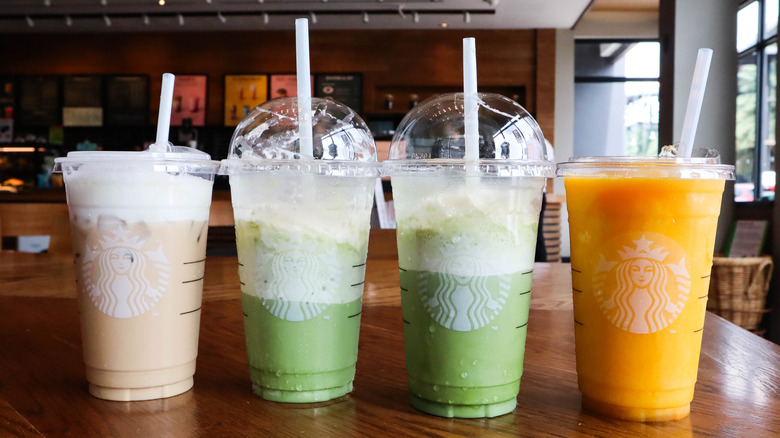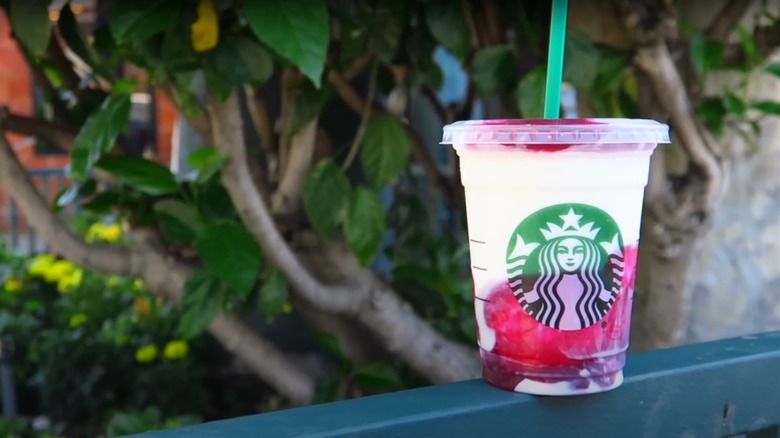How Starbucks Failed At Making Smoothies
We all have our go-to Starbucks drink, but it's still always exciting when the company tests products or adds new items to its permanent menu. Just as some drinks take off and become favorites, like Starbucks frozen lemonade Refreshers, other novelty drinks have not fared as well. Starbucks' beer-inspired latte, for example, was quickly discontinued.
Other drinks have come and gone and are mostly forgotten. We're willing to bet you don't remember the Chantico, Starbucks' attempt at selling drinkable dessert chocolate. Or the Mazagran, which has probably been wiped from your memory as well. That was the brand's odd, bottled coffee and cola drink, in partnership with Pepsi — it did not last long.
Two memorable failures do stand out, however, if only because they both had potential and were released around the same time. The Vivanno was essentially a smoothie, marketed as a healthy alternative that was high in both protein and fiber. But let's not forget Starbucks' similar failure, an Italian take on sorbet. The Sorbetto was an icy, slushy-style drink that was, for all intents and purposes, a fruity version of a Frappuccino — but with more sugar by size. Neither fruity infusion hit the mark with enough customers to last very long, with the Sorbetto not even making it out of the testing phase in California.
Why the Vivanno smoothie failed ... or did it?
The Vivanno had a lot going for it. The smoothie was geared toward the health-conscious consumer and touted as a nourishing blend made without added sugar or artificial sweeteners. As noted in the product's 2008 press release, the simple ingredients included a banana, whey protein and fiber powder, a choice of milk, and ice. It was available in two flavors, Banana Chocolate or Orange Mango Banana — the latter of which was also made with Naked juice.
Each 16-ounce serving contained 16 grams of protein, 5 grams of fiber, and had only 270 calories or less. The standard Vivanno did not have any caffeine, but it was customizable with shots of espresso or matcha green tea powder (which would also bump up its amount of vitamin C).
Perhaps unsurprisingly, people liked the Vivanno, but it didn't get enough love to warrant a permanent addition to Starbucks' line-up. The drink was not very sweet on its own unless modified, which didn't appeal to those looking to satisfy their sweet tooth. With its high-protein content, the Vivanno was more like a meal replacement than a treat, which ultimately didn't earn it too many fans. Interestingly, after the drink was pulled from Starbucks' menus, the beverage continued on in its second life as the base for unnamed smoothies, which are still available at some Starbucks locations in a variety of flavors. The Vivanno is dead; long live the Vivanno, err, unnamed smoothie!
The short but sweet life of Starbucks' Sorbetto
Sorbettos were first tested in Seattle in 2008, before expanding into approximately 300 Starbucks stores in Southern California throughout Los Angeles and Orange County. By 2009, they were no longer available. The Italian-inspired fruity faux-Frappuccino was made with yogurt and came in two flavors — plain Pinkberry (yogurt) and Citrus Ice flavors. But it offered various mix-ins to create other flavors, like Tango Mango, Tangy Citrus, and Mixed Berry. The texture was like a creamy slushie and required special machines to produce — similar to those used for making Slurpees.
It's these machines which may have been the Sorbetto's undoing. They were big and bulky and required intensive cleaning and maintenance procedures that added hours of additional work for the staff to have to contend with. Starbucks baristas reportedly hated the contraptions, which took up a lot of precious space and added annoying responsibilities.
While the Sorbetto received some positive reviews, it mostly failed to impress, leaving some people unsure if it was a beverage or a dessert. It also probably didn't help that it was released during the height of the three-year Great Recession when people were spending less, and it was harder to justify paying for what amounted to basically an expensive frozen yogurt drink. This overall cool reception of the fruity drink doomed it to never making it past the West Coast.



